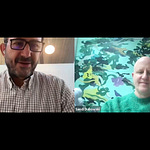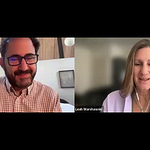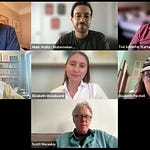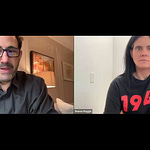I have been a fan of Gary Hustwit since I saw Helvetica and then spoke to him about how he created a unique and hugely successful distribution campaign for that film including some of his practices in Think Outside the Box Office. Since then, I have been in awe of how he has created a deep relationship with his fan base and utilized to a wonderful extent nearly all the techniques available to filmmakers to create a wide range of film products that his audience wants - events, merchandise etc. I still love the sealed signed and numbered hard drive of Helvetica that he sold from his website knowing full well that his collector audience would snap them up.
I was lucky enough to see the film’s world premiere at Sundance 2024, fond memories of dropping my suitcase upon arrival and racing to the Thursday afternoon screening at The Ray. With Eno, Gary gave audiences an experience as close as possible to what music fans have with bands — where each live experience is unique — and if you miss it — you have missed it forever. What a way to motivate people to get out to the theater!
As you can imagine, doing this case study and being able to interview producer Jessica Edwards and distribution consultant Emily Rothschild about how they conceptualized, strategized and executed the release of Eno, was not only exciting, but essential to me. The result is a deep dive into how a film’s release strategy can embody its creative essence. I do recommend watching or listening to the whole webinar but we have highlighted the key points here:
With Eno, the team ditched a one-size-fits-all approach in favor of infinite possibilities. As you probably know, director Gary Hustwit envisioned the film as generative — and with a team created a complex LLM/AI to create a unique version of the film every time it screened. Each DCP (Digital Cinema Package) is different, making every audience experience truly unique. The conversation explored the opportunities, challenges, and lessons from this experimental strategy, including their bold pivot away from traditional sales.
Important Note: This case study is in a sense a companion piece to the one that Jessica and Emily created for Distribution Advocates. If you are interested in what they did with the release I recommend reading that (perhaps even first) and then listening to this webinar as I designed my case study to be complementary to that and not repetitive.
What Was the Goal?
The Eno team approached distribution with a singular question: How do you honor the nature of a film that constantly evolves? This wasn’t just about where the film would play, but about how each screening could feel like its own creative act. They wanted to push the boundaries of what a cinematic experience could be — a generative film that changes every time it is played, reflecting Brian Eno’s own artistic philosophy.
Rather than following the conventional indie playbook, they embraced unpredictability and the ephemeral nature of live performance. The idea was to lean into what made the film special rather than force it into a standard release model.
“If you can push the boundaries of cinema, that’s changing the world. And that’s changing art in a sense, right?” — Jessica Edwards
(You know that I believe that all filmmaker primary goals fall into one of four categories: money, career, change the world, audience. You can read much more about that here.)
Sundance & The Decision to Pivot
Like many indie filmmakers, they went to Sundance with the goal of selling the film. The festival is a launchpad, and securing distribution there is often seen as a defining moment. But while offers came in — including mid-six-figure deals — none aligned with their vision.
“I would be lying if I didn’t say we lined up like everybody else to try and sell the film.” — Jessica Edwards
A standard sale would have meant giving up creative control for 20 years, something they weren’t willing to do. A large financial offer would have been tempting but it was equally important to them to find a distributor with an innovative approach and an interest in experimentation. When no distributor surfaced who fit that bill, they knew they had to build another path forward — one that didn’t rely on traditional sales but instead crafted a new kind of release model.Traditional Festivals vs. Experimental Models
One factor in this decision was how much to pursue film festivals. After their Sundance premiere, the team leveraged existing relationships with CPH:DOX, Full Frame festival, and Hot Docs (in Jessica’s hometown of Toronto), among others. But while these festivals helped create additional excitement in the film world, and perhaps continued to assist with a potential sale, a plethora of festivals would not help them achieve their goal mentioned above.
Eventizing the Experience Like a Live Concert
Every Eno screening is a one-of-a-kind event, mirroring the film’s own generative nature. But more than that, they designed their release strategy like a band going on tour. Director Gary Hustwit performed the film live, using a custom-built console to create a unique version at every screening. This wasn’t just an experiment — it was the core of their distribution strategy.
“How can we play the film so that it is a unique experience for everybody who attends?” — Emily Rothschild
To control ticketing, pricing, and revenue flow, they rented out the venues themselves, rather than relying on standard theatrical exhibition deals. They were able to charge a premium ticket price, adjusted based on market, with ticket prices ranging from $25-$40. Note when you have a film with a high need-to-see component, this allows you to effectively monetize via scarcity (one night only special events).
They admitted that this is not a “low effort” approach that might work for every production team, but for this project it was a relatively easy calculus of costs vs. gross sales. While they did utilize some art house theaters for this purpose, they also booked large-scale venues that could accommodate this approach, including the Palace of Fine Arts in San Francisco and the Alex Theater in Glendale, Los Angeles. By January 2025, the film had grossed $328,158 in live events revenue alone.
Can this Film Play Traditional Theatrical?
While they leaned heavily into event screenings, they also saw value in partnering with select independent theaters who they felt could handle the demands of a unique DCP for every show. This would require 35 DCPS (5 screenings a day for 7 days!) for a traditional week-long run. They partnered with Film Forum in NYC who were eager to experiment. They settled on a new DCP each day to reduce the production lift and they ended up with an incredible 12-week theatrical run in New York. They also booked limited theatrical runs at the Roxie in San Francisco and Alamo Drafthouse in Austin and then booked one night screenings of the film into other art houses around the country. Total US theatrical box office: $744,843 Total international theatrical box office: $255,631. Total WW traditional theatrical box office: $531,421. Art House Day January $40,603. Grand Total $1,041,077.
The challenge? Scaling something intentionally designed to be scarce.
NOTE 2: For this case study we did not go into depth about the inner workings of the creation of the DCPs and what that meant for theaters. That is also well covered in the Distribution Advocates Case Study here.
Art House Days — Expanding Theatrical Reach Without Losing Control
While Eno leaned heavily on event screenings and curated theatrical runs, the team wanted to find a middle ground that would allow wider theatrical access without sacrificing creative control. This led to the creation of Art House Days, a unique approach that allowed independent cinemas to screen Eno without the logistical constraints of live performances or ever-changing DCPs.
Art House Days was born out of direct conversations with exhibitors who were eager to screen the film but couldn’t commit to the financial demands of a full event screening. The team worked closely with Art House Convergence and many of the exhibitors who are part of the Distribution Collective (that I am also a part of) to develop a model that allowed smaller theaters to participate while maintaining the film’s exclusivity.
Key takeaways from Art House Days:
A Scalable Theatrical Model: Unlike the fully customized event screenings, Art House Days offered the same DCP version to multiple theaters on a specific date, creating a limited-time-only theatrical experience.
Flexible Pricing & Accessibility: The team adjusted pricing for smaller markets, making it possible for independent theaters to participate without the usual $1,500 minimum guarantee.
Expanding Beyond Major Cities: While Eno had strongholds in New York, LA, and other key markets, Art House Days allowed them to reach theaters across the U.S. that otherwise wouldn’t have been able to screen the film.
The first Art House Day in October saw 74 theaters participate. Due to its success, they repeated the model in January and then launched a monthly Art House Day screening series, treating the film like an ongoing cult experience — a strategy reminiscent of Rocky Horror Picture Show.
How Can A Generative Film Be Streamed?
Live streaming presented a conundrum. How do you maintain the experience of a film that is never the same twice in a digital space? For the first year the team only focused on audience screenings, but they knew they had to expand into streaming to reach audiences without access to the venues the film played in.
Their out-of-the-box solution: To commemorate the one-year anniversary of their Sundance premiere, they launched a 24-hour global streaming event. On January 24, they streamed six different versions of the film, interspersed with Q&As and musical guests, with Gary staying up for the whole 24 hours to guide the event. They ultimately sold over 7,000 tickets at $24 each, grossing approximately $168,000 in one day. By limiting access within the world of streaming, they preserved some of the exclusivity that made Eno special and kept their options open for future opportunities.
“First year only brick and mortar. Streaming for the movie is complicated — so we had to come up with ideas out of the box.” — Jessica Edwards
Audience Building, Years in the Making
This kind of success does not appear out of thin air. It comes from understanding of (subject of a future post):
Who is your audience?
How can you reach and engage that audience?
What value do you provide your audience?
How does your audience consume media?
We’ve already covered the latter 2 (and the webinar does in more depth). The Eno release success wasn’t just about the strategy and execution — it was about the audience - some of whom had been cultivated for years beforehand.
Gary Hustwit has been building an audience for 20 years. His past work — like Helvetica — already had a following among film nerds and documentary geeks, and his fan base was primed for something experimental.
Brian Eno’s existing community. They tapped into pre-existing Eno fan groups, audiophiles, architects and designers, even some car people — audiences who were already engaged in the creative philosophy of the film.
Promoted like a concert. The marketing strategy mimicked live music events, using Instagram and event ads (~$900/month), college radio, and key partnerships (record stores, music press, influencers). With their core creative team comprised of influencers such as Gary and Brian Eno making authentic short form content, along with the help of Teenage Engineering, they had great performance on their organic social media as well.
Their total ad spend? $10,000-$15,000 — a fraction of what a studio would spend, yet highly targeted.
The Numbers: A Year in Review
Throughout the webinar, Jessica and Emily referenced key figures that illustrate the impact of this approach. For ease of reference, here’s a consolidated look at what they achieved:
Total USA Gross: $731,135
International Gross: $232,432
Theatrical Gross: $298,989
Special Event Screenings: 39 events
Special Event Total Revenue: $342,587
Highest Grossing Single Event: $68,750 (1,459 guests)
Art House Days (October Only) Total Gross: $89,558 (74 theaters)
Global 24-hour Live Stream: 7,000 tickets @ $24 each = $168,000
Total Global Theatrical/Event Box Office: $1,041,077
Since the film has not screened as an event in many parts of the world, the team is still looking towards another year of event theatrical, particularly in Japan and Latin America. Having successfully proven that audiences truly do want to go to theaters to witness something special, they are still considering how to engage the other rights to exploit in ways that deepen the film’s vision.
These figures underscore what’s possible when filmmakers develop a long term audience, own their distribution process and rethink traditional models.
Final Takeaways for Indie Filmmakers
The Eno case study isn’t just about one film — it’s a blueprint for rethinking how independent films engage audiences.
Your film’s identity should dictate your release strategy. If your film is unconventional, your release should reflect that.
A sale isn’t always the best outcome. Retaining ownership can give you greater creative and financial control.
A small group of people achieving a big dream costs less, with a lot of potential upside, and can allow the team to pivot quickly when and where necessary.
Event-driven strategies work, but they require effort. If you want audiences to care, you have to put in the work to build that engagement.









